Community contributions to MariaDB
One of the goals of the MariaDB Foundation is to help new contributors understand the source code and to lower the barrier for new participants. One way to measure this is to look at the number of pull requests received and accepted, as these mostly reflect community contributions. The figures below are for the main server only, not any of the connectors or tools hosted on the Foundation’s GitHub account, and for the period 1 January to 1 July 2017.
Number of GitHub pull requests received: 126 (+113% Year-on-Year)
Number of pull requests reviewed: 102 (+76% YoY)
Number of contributors: 28 (+22% YoY)
Number of reviewers: 13 (+44% YoY)
By comparison, here are the equivalent figures for MySQL:
Number of GitHub pull requests received: 35 (-10% Year-on-Year)
Number of contributors: 19 (+27% YoY)
Although the MariaDB codebase is large and complex, we’re happy to see that there have been some interesting and important contributions from the community.
Notable contributions (merged):
PR#323 – Individual flush commands for different log types for mysqladmin
PR#332 – mysql now reports query time with millisecond precision
PR#381 – third parameter of LPAD() and RPAD() is now optional
PR#383 – Added Oracle compatible CHR() function
Notable contributions (still to be merged):
PR#318 – Server error messages in Hindi
PR#321 – Shell-style alias/unalias commands for MariaDB client
PR#354 – Porting the proxy protocol code from the latest percona
PR#408 – Instant add column for InnoDB

i have idea about master and slave replication.i think master and slave can mount a same disk,master mount by rw,and slave mount readonly, then slave like linux tail to monitor file change and master write to this disk binlog. but i don’t find replication technology like this,i want to know why.think you.